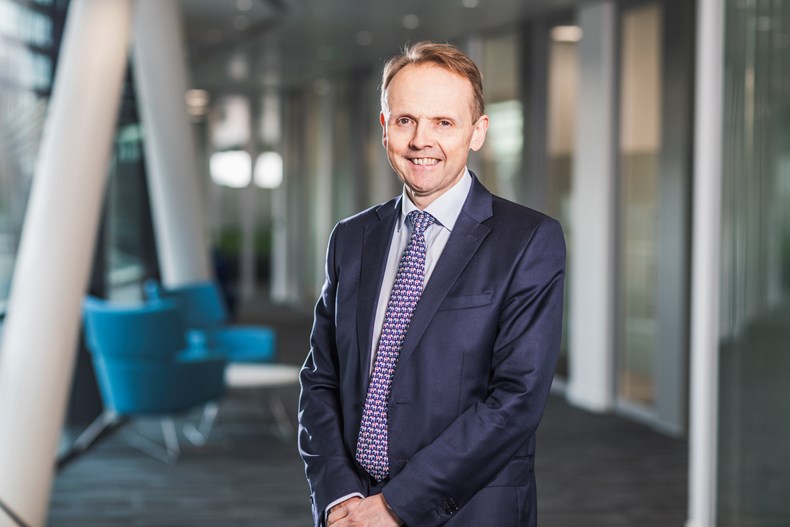
In August 2021, the president of Cop26, Alok Sharma, pressed the button sparking the blowdown of SSE’s former Ferrybridge C power station, near Leeds. Anyone watching its 200-metre chimneys, so long a fixture of the area’s skyline, collapse was witness to a milestone moment in the UK’s march towards carbon neutrality: Ferrybridge C had provided electricity for more than 50 years – all fuelled by coal.
But our growing awareness of the climate emergency requires a fundamental shift in how we power our lives. As world leaders convene for Cop26 against a backdrop of severe wildfires and rising temperatures, the need to meet global net zero targets couldn’t be more stark. The world is at risk of exceeding the 1.5C limit for warming set by the Paris Agreement unless businesses and individuals – and the power companies supplying them – make some explosive changes in the name of decarbonisation.
“There’s a lot that energy companies can do, but we need to be brave,” says Alistair Phillips-Davies, CEO of SSE. “We have to stare into the abyss, by looking at the signs of environmental crises around us, and making sure we’re educated about what’s going on. And then we have to make bold decisions about how to move forward with the huge levels of investment that are available.”
In October, the government announced its pledge to decarbonise the electricity system by 2035 – bringing the original target date forward by 15 years. And SSE has shown the way by demonstrating a deep commitment to renewables.
It’s leading development of the world’s largest offshore wind farm at Dogger Bank, off the coast of Yorkshire. The 3.6GW Dogger Bank wind farm will produce enough clean, renewable electricity to supply 5 per cent of the UK’s demand, equivalent to powering six million homes every year. Total investment in the first two phases of the project will be around £6 billion.
SSE is also a lead partner in Scotland’s largest offshore wind farm, Seagreen, off the coast of Angus; and one of Europe’s most productive onshore wind farms, Viking, a 103-turbine farm on the Shetland Islands.
These are critical developments. A carbon neutral future requires flexible, renewable energy that drives the necessary shift to truly sustainable ways of living while meeting ever-changing energy needs.
According to the government’s Climate Change Committee, for example, the widespread adoption of new technologies such as electric vehicles will spark a two to three-fold increase in UK electricity demand.
Coire Glas, SSE’s proposed 1,500MW pump storage facility in the Scottish Highlands, offers the perfect solution: using strong winds at periods of low demand to power pumping water to a higher reservoir, water that can then be used to power hydro plants when demand is high. Coire Glas promises to more than double the current amount of pumped hydro storage capacity in the UK.
Despite these innovations, Britain and the wider world are still at the early stages of the decarbonisation journey.
"This is a hugely important decade, it’s an exciting time for SSE, and we’ve shown a great deal of leadership as a company. No one in the world is building more offshore wind facilities. But there are a host of other things we need to be getting on with now."
Alistair Phillips-Davies, CEO of SSE
To look at SSE’s future plans is to see the central role that electricity companies must play in decarbonising the rest of industry. Beyond investment in generating renewable energy, it’s exploring the potential of battery technology, with an eye on developing a large UK-wide portfolio in shorter-duration storage. It is also looking at developments in carbon capture and storage to further boost its supply of flexible energy, which can later be adapted to future use of hydrogen.
There’s also the need to radically update the nationwide network of cables in order to transmit the power from these new renewable sources for seamless use by businesses around the country.
Yet while electricity companies have the responsibility for kickstarting wider decarbonisation, they also stand to gain a huge amount from making the transition to clean energy – benefits that will translate directly to their workforces.
SSE has, for example, made an explicit commitment to retrain people from high-carbon industries and bring them in to long-term, low-carbon jobs. In October, GE Renewable Energy began work on its massive new turbine blade factory in Teesside for Dogger Bank. That alone is set to create 2,000 new roles.
So not only is a net zero power sector key to unlocking the electrification – and decarbonisation – of other industries, it clearly has a central role to play in plugging the burgeoning skills gap too.
The threats and challenges, innovations, and the potential gains for the workforce and wider society will all be front and centre in November as the world’s political, business and climate leaders convene for Cop26, the biggest environmental event since leaders met in Paris in 2015 and set the original net zero goals.
For Phillips-Davies, energy companies will be seeking one thing above all others from this meeting: certainty.
“For businesses like ours, here and round the world, clear policy always helps,” he says. “The UK’s recent commitment to decarbonise the electricity system by 2035 is a great example.
“The centrepiece of what we’re looking for from Cop26 is a commitment to keep the temperature rise below 1.5 degrees. And with that we need strong leadership from governments and policymakers, setting ambitious but achievable targets that clearly incentivise businesses to go and do what they do best: innovate ways to work better, faster, and more efficiently.”
This article first appeared in the Times and Sunday Times


